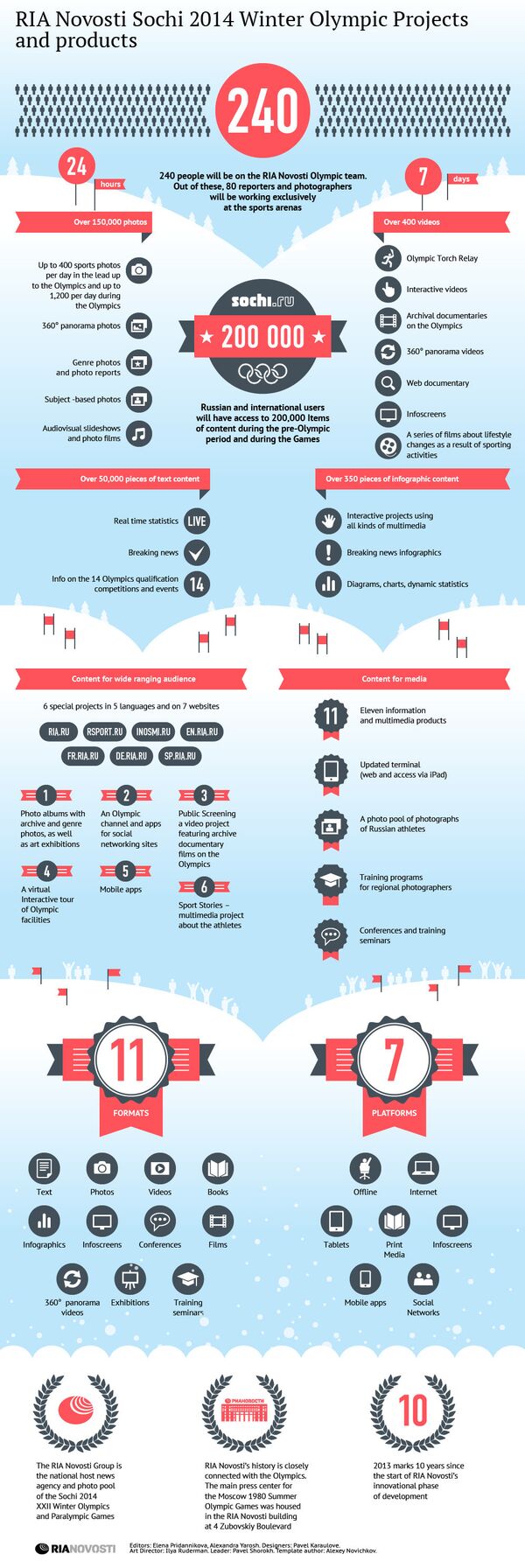MOSCOW, March 21 – RIA Novosti. RIA Novosti Group has performed all its obligations as Host National News Agency and National Olympic Photo Pool for the Sochi 2014 Olympic Winter Games by covering the Sochi 2014 Paralympic Winter Games.
The Paralympics are closing the Olympic program, which hundreds of RIA Novosti employees had worked on during the past four years.
In September 2011, the International Olympic Committee (IOC) granted the status of Sochi 2014 Host National News Agency and National Olympic Photo Pool to RIA Novosti Group, which includes R-Sport sports news agency. In March 2013, RIA Novosti was named Host National News Agency and Photo Pool for the Sochi 2014 Paralympic Winter Games. The opportunity to cover the Olympic and Paralympic games was a great honor and a major professional challenge for the RIA Novosti staff. Under IOC rules, a national photo pool is to chronicle the events and mete out photographs to the national media. To be able to do so, the agency spent four years to study and introduce innovative methods for transmitting and presenting multimedia sports content.

“Getting the status of Host National News Agency and Photo Pool for the Sochi 2014 Olympic and Paralympic Winter Games was a great honor for the RIA Novosti team,” said RIA Novosti’s First Deputy Editor-in-Chief Maxim Filimonov. “It’s an invaluable experience, and we are proud of having the opportunity to participate in chronicling the Olympic Games.”
The establishment of R-Sport sports news agency in 2012 as a specialized unit to cover the Olympic Games was an important step down this road. Created on the basis of the RIA Novosti sports desk, the agency emerged as the most quoted sports medium, confirming the group’s competence in the field of sports and its readiness to cover the games.
RIA Novosti journalists, engineers and managers worked hard to put the new technology and information arrangement in place by summer 2013. The World Student Games in Kazan and the World Rhythmic Gymnastics Championship let the agency test the new solutions, with the result proving quite “Olympic”. During the World Student Games, for example, R-Sport websites offered about 50 multimedia stories a day. RIA Novosti photographers and video correspondents took nearly one thousand photographs and not fewer than two videos per day, and published textual and video interviews with Russian athletes and coaches. RIA Novosti launched its Blitz photo content delivery system that contributes a photo with metadata (an athlete’s name and event) to the image bank within ninety seconds of a photographer pressing the shutter button. It also tested Mark Roberts Motion Control (MRMC) robotized systems providing informative and pictorial angle shots.
Covering the Olympics required an even greater concentration of effort and a constant search for original solutions, from creating a sophisticated IT infrastructure at Olympic facilities, to evolving fundamentally new journalistic formats, to developing client products. RIA Novosti’s image bank made it possible for Russian central and regional media to access Olympic photographs free of charge and practically in real time. During the Winter Olympics, RIA Novosti organized a media center for over 4,000 non-accredited journalists, who thus gained access to current information and could interview Russian medal winners and their coaches. Its mobile apps – Second Screen, Winter Games and Media Center – communicated current news and reference information to both the fan and professional communities.

RIA Novosti used most original techniques while covering the Olympics. The agency’s video department came up with an interactive video panorama, “A Virtual Tour of Sochi,” and a web documentary, “What It Costs to Win a Medal,” dedicated to athletes’ stories and the high price they have to pay for victory. Moscow, St. Petersburg and Sochi hosted six photo exhibitions. More than 500,000 people visited RIA Novosti’s Olympic displays, and another 50 million watched its Olympic content on information screens, while its total Internet audience amounted to 15 million unique users.
The culmination of the Olympic and Paralympic Games coincided with the winding down of RIA Novosti and the creation on its basis of Rossiya Segodnya International Information Agency.
“It’s highly symbolic that such a large-scale, historic project draws the bottom line under RIA Novosti’s present-day history,” Mr. Filimonov said. “Covering the Olympics was the high point of its 10-year-long innovative development. The agency used its entire pool of energy, knowledge and professionalism, putting Russian news journalism on a new technological level. In effect, what RIA Novosti achieved during the Olympics – in delivery speeds, quality of content, genre variety and technology levels – has combined to form a new professional standard that is certain to play a role in the further progress of Russian media. And this is RIA Novosti’s main Olympic achievement.”



